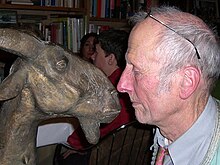Bremen Green List
| Bremen Green List | |
|---|---|
| founding | 1973 |
| Place of foundation | Bremen |
| resolution | circa 1982 |
| Alignment | Green politics |
| Colours) | green |
| Parliament seats | 4 (1979-1982) |
The Bremen Green List (short name: BGL ) was the first green party to enter a state parliament in 1979 .
founding
The Bremen Green List has its roots in a citizens' initiative against the Mozart route , which, according to the plans of the Senate and the SPD parliamentary group of Bremen's citizens , should cut through the district as a bypass . On December 5, 1973, the resistance of the SPD base led to a negative decision regarding the "Mozart route" in the SPD parliamentary group after the parliamentary group had spoken out in favor of the plans the day before. On the part of the SPD leadership, after the end of the "Mozart Route", in order to prevent massive resistance from the base in the future, the previously unified SPD urban district was divided into three sub-districts. This led to 18 party withdrawals and the establishment of the Bremen Green List by a group of former SPD members around Olaf Dinné .
In addition, the conservative CDU split-off party Free Citizens participated in the establishment. In the so-called "Bremen Model" an attempt was made to organize the Green Movement as a broad social alliance. Of Rudi Dutschke on liberal representatives of new social movements, the Alliance was welcomed as a political opportunity.
Entry into the citizenry
In 1979 the BGL succeeded in gaining 5.14% of the votes in the city of Bremen in the election for Bremen's citizenship and was the first green party to be represented in a state parliament . The four members of the BGL in the citizenry were Olaf Dinné, Axel Adamietz , Peter Willers and Delphine Brox .
“They stuck together, they knew that they had a sensible goal, and we were basically hopeful, of course, but perplexed that we had achieved this success here in Bremen. That was just a very exciting time. "
“That was the first time that green MPs were ever elected to a state parliament. In this respect, the level of attention was very, very high not only in Bremen, but in the whole of Germany. And in retrospect you have to say that they mixed up a lot. "
Disintegration and dissolution
In addition to the BGL, a regional association was formed alongside the BGL in Bremen as a result of the establishment of the nationwide party “ The Greens ”. There were disputes within the BGL. In 1982, the BGL member Peter Willers resigned from the community of members and the BGL and joined the Greens. In the general election on September 26, 1983 , three green groups competed in Bremen: The Greens with Willers as the top candidate , the BGL around Dinné and the DKP -near company alternative list . Only the Greens were able to move into the citizenship with 5.4% of the vote.
The four members of the BGL withdrew in the course of time from politics. Adamietz became a member of the FDP in 1990 and of the Bremer und Bremerhaven voter community (B + B) in 2011, and Dinné was involved in various citizens' initiatives against a new urban motorway project long afterwards. Willers was a member of the parliament until 1985 and resigned from the Greens in 1991. Until her death in 2008, Delphine Brox was involved in local environmental initiatives in her French hometown of Cussy-en-Morvan, where she fought in particular against the settlement of industrial pig farms.
See also
Web links
- Deutsche Welle, calendar sheet for the entry of the BGL into the Bremen citizenship
- When Germany turned green, in the Hamburger Abendblatt of October 15, 2004
Individual evidence
- ↑ Clemens Stromeyer: Origin and development of the GREENS up to their entry into the German Bundestag. GRIN, 2007. page 52.

